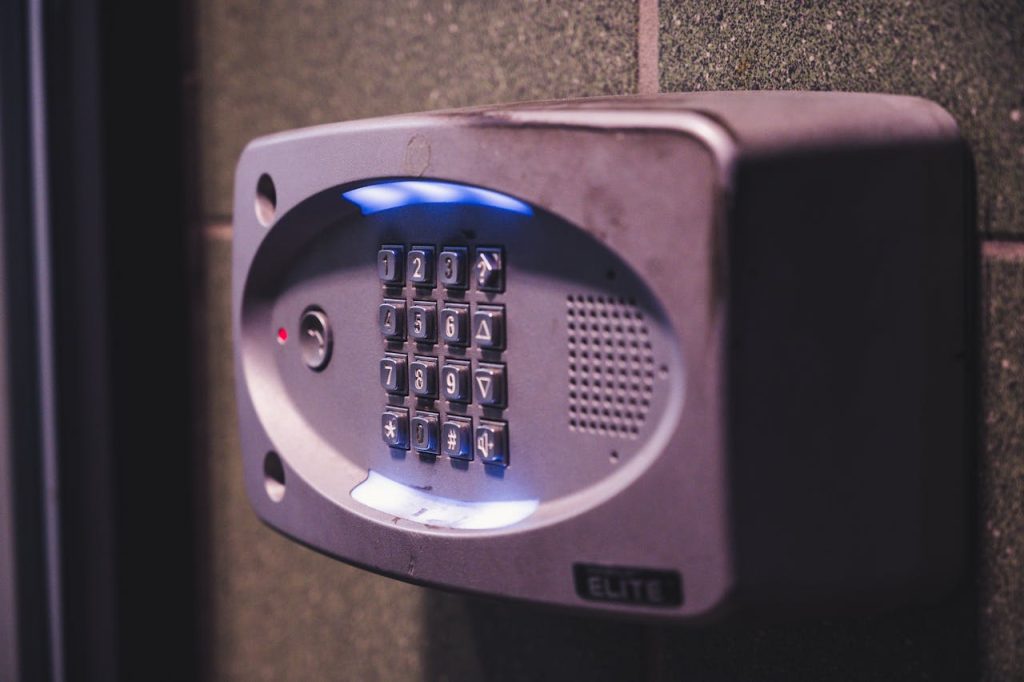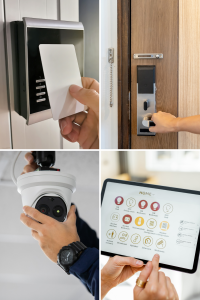With the increase in remote work, securing a home office has become essential for protecting sensitive data and valuable equipment. Unlike traditional office environments, home offices often lack built-in security measures, making them vulnerable to both physical and digital threats. This guide covers practical steps to secure your home office, from safeguarding against theft to implementing cybersecurity practices for safe data management.
1. Establish Physical Security Measures for Your Home Office
Protecting your home office from physical threats is a critical step, especially if you handle sensitive information or have valuable equipment.
Key Steps for Physical Security:
- Secure Doors and Windows: Ensure all doors and windows near your home office are locked. Consider upgrading to smart locks for additional control over access points.
- Install Security Cameras: Positioning a camera outside your office space can help you monitor any suspicious activity. Many smart cameras offer mobile alerts, allowing you to stay informed even when away.
- Use Lockable Storage for Valuables: Store laptops, important files, and other valuables in a lockable cabinet or drawer when not in use. This added precaution reduces the risk of theft, particularly in shared spaces.
- Limit Access to Your Home Office: If you live with others, set clear boundaries around your workspace to minimize traffic and prevent accidental access to sensitive information.
2. Cybersecurity Measures to Protect Sensitive Data
Cybersecurity is vital for remote work, particularly if you handle sensitive client information or confidential company data. Adopting essential cybersecurity practices can protect your data from digital threats.
Cybersecurity Best Practices:
- Use a VPN (Virtual Private Network): A VPN encrypts your internet connection, securing your data against potential hackers. This is especially useful if you occasionally work from public Wi-Fi networks.
- Enable Two-Factor Authentication (2FA): Two-factor authentication adds an extra layer of security for your online accounts by requiring a secondary form of verification, such as a text message code.
- Regularly Update Software and Devices: Keeping your computer, software, and apps up-to-date ensures the latest security patches are installed, reducing vulnerabilities.
- Set Strong, Unique Passwords: Avoid reusing passwords across accounts, and ensure each password is complex. A password manager can help you store them securely and conveniently.
3. Secure Your Home Wi-Fi Network
An unsecured Wi-Fi network can make it easy for cybercriminals to access your devices and sensitive information. Taking steps to secure your Wi-Fi is essential to protecting your home office.
Steps to Secure Your Wi-Fi:
- Use WPA3 Encryption: Protect your network with WPA3 encryption, the latest standard for secure connections.
- Set a Strong Wi-Fi Password: Use a complex password with letters, numbers, and symbols, making it harder for unauthorized access.
- Disable Remote Access: Turning off remote access prevents external parties from connecting to your network.
- Create a Guest Network: Set up a guest network for visitors to keep them separate from your main network, adding an extra layer of security.
4. Invest in Anti-Virus Software and Firewalls
Anti-virus software and firewalls provide an essential layer of protection against malicious software and cyber threats. These tools are especially important for any home office handling sensitive information or connecting to company networks.
Benefits of Anti-Virus Software:
- Real-Time Threat Detection: Anti-virus software can detect and block malware, ransomware, and other malicious software in real time.
- Regular Scans: Schedule regular scans to identify and remove potential threats on your devices.
- Firewall Protection: A firewall helps block unauthorized access to your computer, offering additional security for your home office network.
5. Set Up Secure Backup Solutions
Data loss can occur due to hardware failure, accidental deletion, or cyber attacks. Backing up work files is essential for protecting valuable information and minimizing workflow interruptions.
Best Practices for Backups:
- Cloud Backup Services: Use cloud storage services like Google Drive, Dropbox, or Microsoft OneDrive for convenient access and automatic backups.
- External Hard Drive: A physical backup on an external hard drive adds another layer of security. Store it in a safe place to protect against damage or theft.
- Automated Backups: Set up automatic backups to ensure files are saved regularly without requiring manual effort.
6. Implement Physical Device Security
Securing your devices is crucial for protecting sensitive data and minimizing risks in a shared or open workspace.
Steps to Secure Your Devices:
- Enable Device Passwords and Encryption: Use strong passwords and encryption on laptops, tablets, and mobile phones to secure data in case of loss or theft.
- Turn on Location Tracking: Many devices offer location tracking, allowing you to locate them if they go missing.
- Install Security Apps: Security apps enable you to remotely lock or wipe your device if it’s lost or stolen, preventing unauthorized access.
7. Create a Secure Workspace for Video Calls and Meetings
Virtual meetings have become essential to remote work, but they also carry privacy risks. Establishing a secure area for video calls can help protect your information and reduce distractions.
Tips for Secure Video Calls:
- Choose a Private Area: Ensure your workspace is private, reducing the risk of eavesdropping or accidental exposure of confidential information.
- Use Secure Meeting Platforms: Select reputable video conferencing software with strong encryption, such as Zoom, Microsoft Teams, or Google Meet.
- Enable Waiting Rooms and Passwords: Use waiting rooms or passwords to prevent unauthorized participants from joining your calls.
8. Limit Access to Your Work Devices
Limiting access to your work devices can help prevent unauthorized use, particularly in a shared living space.
Ways to Limit Access:
- Use Lock Screens: Always lock your devices when not in use to prevent others from accessing them.
- Set Up Separate User Profiles: If sharing a device with family members, create separate user profiles with different access levels.
- Store Devices Securely: When you’re not working, store your devices in a safe location to prevent accidental access or tampering.
9. Establish Work Boundaries with Family and Roommates
Setting boundaries with family members or roommates helps secure your workspace and minimize disruptions. Communicate that your workspace and devices are strictly for work, and encourage respect for this area.
Tips for Establishing Boundaries:
- Designate a Private Work Area: Choose a dedicated workspace that others avoid during work hours.
- Communicate Your Schedule: Let household members know your work schedule so they understand when you need privacy.
- Set Clear Rules for Device Use: Explain that your work devices are for professional use only, helping to prevent security issues.
10. Regularly Assess and Update Your Home Office Security
Keeping your home office secure requires ongoing attention. Regular assessments can help you identify potential vulnerabilities and make necessary adjustments.
Steps to Regularly Assess Security:
- Review Cybersecurity Practices: Evaluate your password strength, update software, and consider new security tools.
- Test Physical Security Devices: Check that locks, cameras, and alarms are functioning properly.
- Update Security Tools: Stay informed about new tools and upgrades, such as improved anti-virus software or advanced VPN options.
Conclusion
Securing your home office is essential for protecting sensitive data, ensuring productivity, and giving you peace of mind. By implementing both physical and digital security measures, you can create a safe, efficient workspace that supports your remote work needs. From securing your Wi-Fi and encrypting devices to establishing boundaries with household members, each step contributes to a well-protected home office environment.
Remote work presents unique security challenges, but by following these tips, you can enhance your workspace’s safety, protect valuable information, and stay focused on your tasks.





